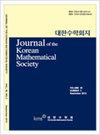没有单色循环的彩色排列
IF 0.5
4区 数学
Q2 MATHEMATICS
引用次数: 0
摘要
(n 1,n 2,…,n k)色置换是n 1+n 2+·+n k的置换,其中1,2,。。。,n 1具有颜色1,并且n 1+1,n 1+2。。。,n1+n2有颜色2,依此类推。我们给出了Stein-hardt结果的双射证明:没有单色循环的有色排列的数量等于按升序排列第一个n1元素、下一个n2元素等后没有固定点的排列的数量。然后,我们确定了没有单色循环的有色每个突变的生成函数。作为一个应用,我们给出了一个新的证明,证明了无固定颜色的彩色排列的生成函数,也称为多重排列。本文章由计算机程序翻译,如有差异,请以英文原文为准。
COLORED PERMUTATIONS WITH NO MONOCHROMATIC CYCLES
. An ( n 1 ,n 2 ,...,n k )-colored permutation is a permutation of n 1 + n 2 + ··· + n k in which 1 , 2 ,...,n 1 have color 1, and n 1 + 1, n 1 + 2, ...,n 1 + n 2 have color 2, and so on. We give a bijective proof of Stein- hardt’s result: the number of colored permutations with no monochromatic cycles is equal to the number of permutations with no fixed points after reordering the first n 1 elements, the next n 2 element, and so on, in ascending order. We then find the generating function for colored per- mutations with no monochromatic cycles. As an application we give a new proof of the well known generating function for colored permutations with no fixed colors, also known as multi-derangements.
求助全文
通过发布文献求助,成功后即可免费获取论文全文。
去求助
来源期刊
CiteScore
1.20
自引率
16.70%
发文量
0
审稿时长
6-12 weeks
期刊介绍:
This journal endeavors to publish significant research of broad interests in pure and applied mathematics. One volume is published each year, and each volume consists of six issues (January, March, May, July, September, November).

 求助内容:
求助内容: 应助结果提醒方式:
应助结果提醒方式:


